|
The Environmental Effects
of Heavy Metal Pollution
Since 1975 catalytic converters have been used to remove gaseous pollutants
from automotive exhaust. Chemical reactions within the converters change
the targeted pollutants into less toxic substances. Today catalytic converters
are mandatory on automobiles, and -- as a result of the Clean Air Act
of 1990 -- they are also required on small gasoline engines such as those
on lawn mowers, chain saws, and other power tools.
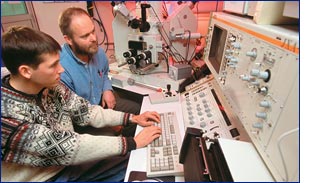 The material used to excite the reactions within the converters is filled
with platinum, palladium, and rhodium -- platinum-group elements (PGEs),
which can potentially become carcinogenic when they complex with organic
matter. “It’s ironic,” says Clive
R. Neal, associate
professor of civil engineering and geological sciences and director of
the college’s Inductively Coupled Plasma-mass Spectrometry Facility, “that
man’s efforts to prevent pollution may prove as toxic to the environment
as the pollutants society originally hoped to abate.” The material used to excite the reactions within the converters is filled
with platinum, palladium, and rhodium -- platinum-group elements (PGEs),
which can potentially become carcinogenic when they complex with organic
matter. “It’s ironic,” says Clive
R. Neal, associate
professor of civil engineering and geological sciences and director of
the college’s Inductively Coupled Plasma-mass Spectrometry Facility, “that
man’s efforts to prevent pollution may prove as toxic to the environment
as the pollutants society originally hoped to abate.”
A recent study focusing on the catalytic converters on automobiles and
conducted by Neal and other researchers in the colleges of engineering
and science, the University’s Center for Environmental Science
and Technology (CEST), and Wichita State University confirms that catalytic
converters are releasing PGEs. Samples taken at various distances along
several roadways in the United States and Australia contain significant
amounts of these PGEs, quantities above background levels, in each of
the soil samples, especially those closest to the roads. The study suggests
that the amount and rate of PGE release is largely dependent upon the
speed of the vehicle, the type of engine, the type and age of the catalyst,
as well as the use of fuel additives.
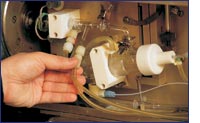 Initial data also indicate that only the platinum is taken up by plants.
However, platinum is a known allergen and has been linked to asthma,
sensitive skin, and other health problems. Although physicians have yet
to determine the main cause of asthma, statistics show an alarming increase
in the United States over the past 15 years. During this time, asthma
rates have increased more than 150 percent in children under five years
of age. Is there a correlation? That’s what Neal and his colleagues
are trying to determine. Initial data also indicate that only the platinum is taken up by plants.
However, platinum is a known allergen and has been linked to asthma,
sensitive skin, and other health problems. Although physicians have yet
to determine the main cause of asthma, statistics show an alarming increase
in the United States over the past 15 years. During this time, asthma
rates have increased more than 150 percent in children under five years
of age. Is there a correlation? That’s what Neal and his colleagues
are trying to determine.
“We know that PGEs are being released, and we know they’re
somewhat mobile,” says Neal. “The next step is to identify
how they are being transported. Are they being oxidized, dissolved in
groundwater,
or taken up by food crops? Are they being distributed by the wind? And,
most important, how mobile are they?”
According to Neal, related studies show that glaciers and other ice formations
on Greenland contain elevated levels of platinum. Given the fact that
there are few highways in Greenland, he believes the obvious conclusion
is that PGEs are somehow transported in the atmosphere. Studies conducted
in Germany and England support this theory.
Neal is also investigating the increasing environmental hazard caused
by contaminated water feeding into groundwater systems. Although sources
of heavy-metal pollution include manufacturing processes, smelting and
refining, electricity generation, and agricultural fertilization, Neal
-- in collaboration with CEST -- has been concentrating on the areas
around abandoned mines.
Mining operations usually require large stabilization ponds covering
many acres. Tailings from the mines -- such as arsenic, copper, nickel,
lead, cesium, zinc, and molybdenum -- are stored in these ponds and often
seep into groundwater supplies. For example, metal contaminated waters
from the Berkeley Pit, part of the Butte Mine Flooding Superfund Site
in Montana, threaten the groundwater supply of the Butte metropolitan
area.
Conventional technologies for removing metals from water supplies rely
on expensive mineral adsorbents or chemical agents. Neal and a team of
researchers from Wichita State University, Argonne National Laboratory,
Notre Dame’s Department of Biological Sciences, CEST, and members
of the Department of Civil Engineering and Geological Sciences have developed
a remediation strategy using biomass byproducts that can effectively
remove large amounts of heavy metals while keeping costs to a minimum.
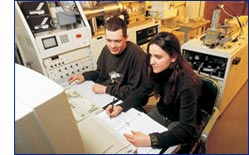 Using a biomass material, in this case the spillage that remains after
ethanol is distilled from corn and ground corn cobs, the biomass team
was able to remove toxic heavy metals more efficiently and cost effectively
than other current processes. As promising as the results of this study
are, what Neal believes to be as exciting is that both the biomass and
catalytic converter projects evolved from brainstorming sessions. “Good
ideas, or rather good solutions,” he says, “are seldom developed
in a vacuum. We have a vibrant environmental geosciences program with
faculty, graduate students, and undergraduates all participating in quantitative
research. When this kind of interdisciplinary team work is applied, the
probability of continuing to engineer practical and earth-friendly solutions
to environmental issues is tremendous.” Using a biomass material, in this case the spillage that remains after
ethanol is distilled from corn and ground corn cobs, the biomass team
was able to remove toxic heavy metals more efficiently and cost effectively
than other current processes. As promising as the results of this study
are, what Neal believes to be as exciting is that both the biomass and
catalytic converter projects evolved from brainstorming sessions. “Good
ideas, or rather good solutions,” he says, “are seldom developed
in a vacuum. We have a vibrant environmental geosciences program with
faculty, graduate students, and undergraduates all participating in quantitative
research. When this kind of interdisciplinary team work is applied, the
probability of continuing to engineer practical and earth-friendly solutions
to environmental issues is tremendous.” |
|
Field Research Opportunities in Environmental
Geosciences
In addition to traditional on-campus research, students in the College
of Engineering have opportunities to participate in study-abroad
and off-campus research projects that add to their classroom experiences.
For example, students entering their junior year may choose to spend
a semester studying in Australia. Curricula and fieldwork opportunities,
developed in conjunction with the University of Western Australia
and six local companies, provide students with practical hands-on
experience.
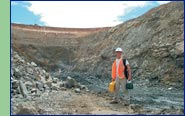 According to Clive R. Neal, associate professor of civil engineering
and geological sciences and coordinator for the study-abroad program
in Australia, students often find themselves in unique field situations
where they must apply what they’ve learned in class ... from
prospecting for nickel deposits in the outback to finding ways to
convert sewer sludge into diesel fuel. Neal has worked closely with
representatives of companies like Collie Mining, Rio Tinto Mining,
Western Mining Corporation, and The Department of Conservation and
Land Management to create service-learning activities for the students. “Course
work is vital,” he says, “but there’s nothing like
firsthand experience.” According to Clive R. Neal, associate professor of civil engineering
and geological sciences and coordinator for the study-abroad program
in Australia, students often find themselves in unique field situations
where they must apply what they’ve learned in class ... from
prospecting for nickel deposits in the outback to finding ways to
convert sewer sludge into diesel fuel. Neal has worked closely with
representatives of companies like Collie Mining, Rio Tinto Mining,
Western Mining Corporation, and The Department of Conservation and
Land Management to create service-learning activities for the students. “Course
work is vital,” he says, “but there’s nothing like
firsthand experience.”
It helps the companies too. Many of the activities developed for
the students revolve around problems the companies have intended
to address but have been unable to do so because of manpower limitations.
At the end of each semester, students write reports and make formal
presentations of their findings to company representatives. Corporate
input is also used in determining students’ grades. Since its
inception, a total of 42 engineering students have participated in
the Australian study-abroad program. And, 80 percent of their suggestions
have been implemented
by the companies.
 The University of Notre Dame Environmental Research Center (UNDERC)
is located on both sides of the state line between northern Wisconsin
and the upper peninsula of Michigan. Thirty lakes, several bogs and
marsh habitats, three streams, and thousands of acres of forest preserves
make UNDERC an ideal location for both aquatic and terrestrial studies.
Although relatively few students from the College of Engineering
have visited UNDERC in the past, Patricia A. Maurice, associate professor
of civil engineering and geological sciences, says that is about
to change. “The UNDERC facility is ideal for a great deal of
our research,” says Maurice. “It offers a variety of
different and very complex systems to study, from the water ... to
the bacteria in it ... to the larger organisms that interact with
it. If we can understand an entire ecosystem, then we may also be
able to find a way to engineer solutions to global environmental
problems.” The University of Notre Dame Environmental Research Center (UNDERC)
is located on both sides of the state line between northern Wisconsin
and the upper peninsula of Michigan. Thirty lakes, several bogs and
marsh habitats, three streams, and thousands of acres of forest preserves
make UNDERC an ideal location for both aquatic and terrestrial studies.
Although relatively few students from the College of Engineering
have visited UNDERC in the past, Patricia A. Maurice, associate professor
of civil engineering and geological sciences, says that is about
to change. “The UNDERC facility is ideal for a great deal of
our research,” says Maurice. “It offers a variety of
different and very complex systems to study, from the water ... to
the bacteria in it ... to the larger organisms that interact with
it. If we can understand an entire ecosystem, then we may also be
able to find a way to engineer solutions to global environmental
problems.”
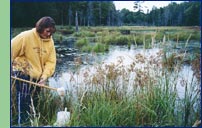 Katie Young, one of Maurice’s graduate students, will spend
summer 2002 at UNDERC investigating how the chemical characteristics
of natural organic matter (NOM) are affected by adsorption of NOM
to bacteria and to mineral surfaces. The National Science Foundation-funded
project will also analyze the photodegradation of NOM by ultraviolet
radiation. Young plans to sample three sites around the UNDERC property
in order to compare NOM reactivity from streams containing a wide
range physicochemical characteristics. “The physicochemical
properties of NOM are important,” says Young, “because
they help control mobility, adsorption kinetics, pollutant binding
properties, adsorption affinity, and bioavailability.” Katie Young, one of Maurice’s graduate students, will spend
summer 2002 at UNDERC investigating how the chemical characteristics
of natural organic matter (NOM) are affected by adsorption of NOM
to bacteria and to mineral surfaces. The National Science Foundation-funded
project will also analyze the photodegradation of NOM by ultraviolet
radiation. Young plans to sample three sites around the UNDERC property
in order to compare NOM reactivity from streams containing a wide
range physicochemical characteristics. “The physicochemical
properties of NOM are important,” says Young, “because
they help control mobility, adsorption kinetics, pollutant binding
properties, adsorption affinity, and bioavailability.” |
|
|
 |
 |
 |
 |
 |
| |
|
|

